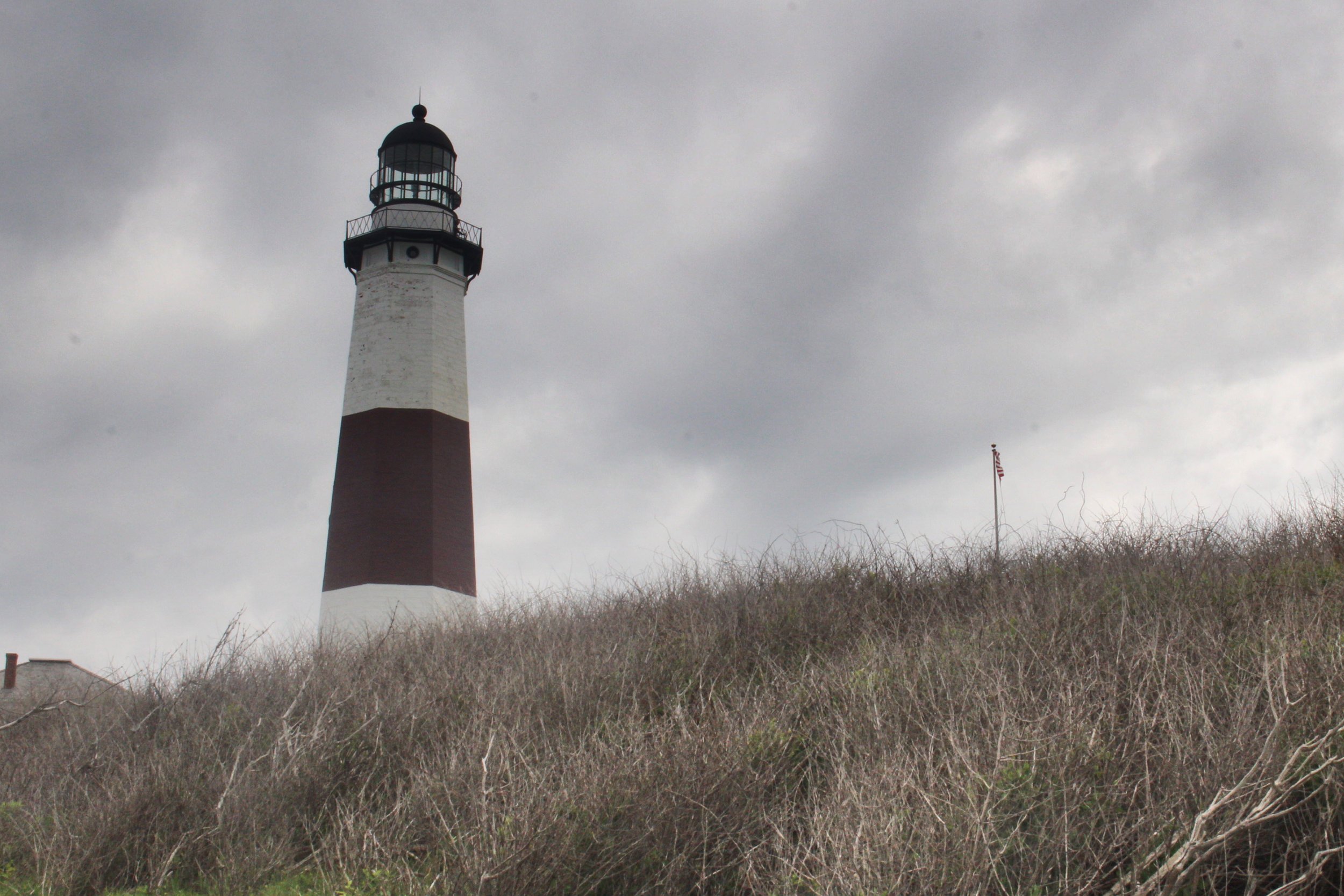Keep Me Where The Light Is Part 1: Orient Point + Montauk Lighthouses
Words and Photography by Rich Nardo
Introduction
As one would expect from an island located just outside a major port, lighthouses have played an important role in the history of Long Island. Since 1796, over twenty five lighthouses have been built on Long Island, each with their own unique story. On the north shore, lighthouses helped sailors navigate the jagged rocks and abrupt shoals of the Sound. On the south side of the island, lighthouses were often the first thing European immigrants saw when they reached their new home.
The Keep Me Where The Light Is series will look at two of Long Island’s lighthouses in each part. The goal is to provide a better view of the underwater geography of Long Island, as well as, the history of some of our most beloved historical structures and how to enjoy them today.
Orient Point Light
“The Coffee Pot”
The Orient Point Light, also known as “the Coffee Pot” due to its appearance, was built in 1899 as a beacon to mark one of the most treacherous stretches of waterway around Long Island. It marks the deep and narrow gap between Orient Point and Plum Island known as the Plum Gut. At ebb tide, the Long Island Sound can reach speeds exceeding five knots as it rushes through the Gut. The churning white-capped waves and powerful riptides in the area are rough enough on sailors, but when combined with the Oyster Pond Reef that extends just below the surface from Orient Point to about one-third of the way across Plum Gut, it can become a savage journey for even the most experienced mariners.
The Coffee Pot. Photo by Rich Nardo
History of “The Coffee Pot”
The construction of the Orient Point Light was anything but easy. In 1855, the Lighthouse Service constructed a daymark on a large boulder that sat on the west side of the Plum Gut. In 1874, almost two decades later, a stone beacon surmounted by a shaft and iron cage was placed on the reef in an attempt to upgrade the warning system. Unfortunately, the treacherous conditions of the area got the best of this beacon and in 1896, less than 20 years later, the marker was carried away by a massive piece of ice.
Understanding the need for something more significant, plans to upgrade the marker with a simple beacon and fog signal were scrapped. Instead, it was decided that a large caisson tower consisting of bolted, curved cast-iron plates would replace the marker that was carried away in 1896. Congress provided a budget of $30,000 on June 4th,1897 to erect this structure at the far end of Oyster Pond Reef. Construction began that October, but a tempestuous Fall greatly hindered the process. Forty-eight prefabricated steel plates were provided to construct the lower two courses of the cylinder. When a particularly strong gale broke twenty of these plates and damaged nineteen others, construction was delayed until the following Spring.
Orient Point Light was finally activated on November 10th, 1899, when its fixed red light was turned on to help guide mariners. Thanks to destructive winter storms and ice floes, an additional 9,000 tons of riprap were necessary to strengthen the 803 ton protective breakwall that surrounded the foundation of the structure. This protective base wound up being twenty-five feet wide at its base and thirty-two feet tall. The lighthouse tower itself is only forty-five feet tall. A few years after the breakwall was refortified, some cracks and rust were found on one side of the foundation, requiring more plates to be added to that side. As a result, the extra weight created a five-degree tilt of the lighthouse tower.
On August 30th, 1912, a steamer known as Halyoake fell victim to the Plum Gut. The Halyoake’s steering suddenly went out and, with the engines still in gear, the strong currents began to carry the vessel directly for the lighthouse. The captain was able to throw the engines into full reverse just in time, but this was yet another example of why the area was so dangerous for mariners.
Twelve years later in May of 1924, Assistant Keeper, John Wallwork, went ashore to retrieve the mail and groceries. While in town, Wallwork met with Walter Gill who was meant to repair an engine at the lighthouse. As the two men were rowing back to the lighthouse, they too fell victim to The Gut. Their rowboat was overturned and sank before Keeper, Manuel Freitas, could reach them. Neither Wallwork nor Gill survived.
On April 5th, 1958, The Coast Guard arrived to clean out the station as it was to be automated. Twelve years later, the lighthouse was deemed unsafe for servicing personnel to repair, and plans were made to tear the Coffee Pot down and replace it with a “reinforced pipe tower”. The local community vehemently protested the idea of losing the iconic lighthouse and the Coast Guard eventually relented. Instead, concrete was pumped into the base and the tower was sandblasted and given fresh coats of paint and epoxy preservative. In the late 1980s, the tower was repainted again, giving it the black with white band appearance we see today.
In June of 2011, the lighthouse was determined to be in excess of the Coast Guard’s needs and made eligible to qualifying private organizations under the National Historic Lighthouse Preservation Act of 2000. No suitable offers were made, and a year later it was opened to an online auction. The winning bid of $120,000 came on September 25, 2012, but this bid ended up falling and a second auction was initiated in June of 2013. Randy Polumbo, an artist and the owner of a New York City construction company known as Plant, submitted the winning bid of $252,000 on September 18th, 2013.
Orient Point Light. Photo by Rich Nardo.
The Coffee Pot Today
Today, the Orient Point Lighthouse is not open to the public. Still, anyone visiting the town of Orient Point can get great views of the iconic Coffee Pot from the shore just passed the parking lot of the ferry station. You will also get a solid look at the Coffee Point and five other lighthouses (Plum Island, Little Gull Island, New London Ledge and New London Harbor, North Dumpling), by taking the Cross Sound Ferry between Orient Point and New London, Connecticut.
The Cross Sound Ferry recently introduced a tour of these six historic lighthouses. Passengers board the ferry service’s high-speed SeaJet, a modern catamaran equipped with two enclosed, air-conditioned decks and a spacious outdoor deck for viewing the scenery where they get a a close up look at the “compelling histories of these lighthouses” according to Director of Public Affairs and Marketing for the Cross Sound Ferry, Stan Mickus.
For a more complete history on the Orient Point Lighthouse, please visit Lighthouse Friend’s entry on it.
Montauk Lighthouse
Montauk Lighthouse. Photo by Rich Nardo.
“The End”
Montauk Point is the furthest eastern point of the south fork of Long Island, and thus of New York State. From the top of the 110’6” sandstone tower, one can get 360-degree views of the Atlantic Ocean and Block Island Sound. It sits atop Turtle Hill, which was named so by the first European settlers. The area was later christened Montauk Point in honor of the Montauket Indians who originally called it home. The tower was originally 300 feet from the edge of the cliff, but due to aggressive shoreline erosion, it is now only 100 feet away from the drop-off point.
Montauk Lighthouse. Photo by Rich Nardo.
The History of “The End”
Even before the lighthouse was erected, the spot served a similar function for Montauk’s native population, as well as, during the Revolutionary War. The Montauket tribe would light signal fires atop Turtle Hill to summon chiefs and warriors to the point when council was needed. The Redcoats (British soldiers) would also keep large fires going here during the Revolutionary War as a beacon for warships blockading Long Island Sound off the coast of Montauk Point.
Montauk Lighthouse. Photo by Rich Nardo.
Montauk Point is the oldest lighthouse in New York State and the fourth oldest active lighthouse in the country. It was commissioned by President George Washington and the Second Congress in 1792. Its creation was the first public works project under the newly independent United States of America.
Ezra L’Hommedieu, a prominent lawyer and member of the Continental Congress, consulted with President Washington on behalf of the New York City Chamber of Commerce regarding the development of the lighthouse. Construction began on June 7th, 1796 and was completed on November 5th. In April of 1797, operations at Montauk Point commenced when its first keeper, Jacob Hand, lit the wicks of the lamps in the tower for the first time.
In 1860, the lighthouse received a major renovation when two levels and a larger lantern were added. This brought the tower from 80 feet to its current height of 110’6”. Montauk Point received another upgrade, this one more aesthetically based, in 1899 when a single brown stripe was added to the all white tower.
In an effort to help mariners navigate around the Shagwong Reef, which sits about three-and-a-half miles northwest of the lighthouse, a fourth-order fixed red range-light was added to the watch deck in 1903. During Prohibition, the isolation of Montauk Point made it an attractive destination for incoming bootleggers. In 1925, Head Keeper John E. Miller and his son (who served as first assistant keeper) were actually suspected of collaborating with sea-borne bootleggers. A severe hurricane damaged this light in September of 1938 and it was subsequently removed in July of 1940 when the lighthouse was electrified.
Montauk Point remained under the supervision of civilian keepers until the US Army took it over during World War II. It was then incorporated into the Eastern Coastal Defense Shield. The Coast Guard took over maintenance in 1946, and operated the station until it was automated on February 3rd, 1987. The Montauk Historical Society would go on to open the lighthouse museum to the public in May of that year on land leased from the Coast Guard. On September 30th, 1996, President Clinton signed legislation authorizing the transfer of the lighthouse property to the Montauk Historical Society.
Montauk Point has always been greatly affected by shoreline erosion, and after World War II, the United States Army Corps of Engineers built a seawall at its base in an attempt to combat it. Erosion continued to be an issue, and, in 1967, the Coast Guard considered replacing the tower with a steel one further from the edge of the bluff. As was the case when a similar plan was proposed at Orient Point, the local community protested and was able to prevent the destruction of the original tower. Instead, the lighthouse was handed over to the Montauk Historical Society so that it could be preserved.
A local Rocky Point textile designer, Giorgina Reid, was tapped by the Montauk Historical Society to help combat the effects of the bluff erosion on the lighthouse. She had used a series of simple terraces in the gullies, which become known as the Reed-Trench Terracing model, to preserve her cottage and proposed using the same method to save the lighthouse. She then worked with a Montauk landscaper named Greg Donohue to implement the Erosion Control Project of Montauk Point, which used local debris and reeds to fortify the bluff. It was successfully completed in 1998.
Unfortunately for Montauk Point, nature always wins, and the erosion became a serious threat again within a decade. Today, the powers at be are still attempting to find the best solution to preserve the lighthouse without negatively affecting the world-renowned surf break that sits just below.
On March 2, 2012, Montauk Point Light was officially designated a National Historic Landmark by then Secretary of the Interior, Ken Salazar. In achieving this stature, Montauk Point become the 14th site on Long Island and the 11th lighthouse in the country to be recognized as such.
George Washington was quoted as saying he believed the construction of the Montauk Point Lighthouse would last 200 years. It seems he was correct as it still stands today!
The End Today
Today, Montauk Point Lighthouse is a popular tourist destination that sits at the end of Montauk State Park, renowned around the world for its fishing and surf break. Its light continues to flash every 5 seconds and can be seen from a distance of 19 nautical miles. For Margaret A. Winski, it also served as home until this year. Winski fulfilled a childhood dream when she was allowed to move into the lighthouse three decades ago. While working full-time for the lighthouse, she would cherish the sight of water “boiling” with schools of fish and fishermen shoulder-to-shoulder along the shoreline. One of her favorite things about living in the lighthouse was standing in the lantern room as snow swirled around the tower during powerful winter storms, which she described as “like being inside a snow globe”. Deciding it was time to move on, Winski plans to fulfill another life-long dream upon leaving the lighthouse by moving to Maine where she will write a book about living in the Montauk Lighthouse. We wish her luck!
For a more complete history on the Montauk Point Lighthouse, please visit Lighthouse Friend’s entry on it.
Montauk Lighthouse. Photo by Rich Nardo
References
Discover Long Island Lighthouse Article - https://www.discoverlongisland.com/things-to-do/famous-long-island/famous-lighthouses/
Long Island Pulse Article on “Long Island’s Lighthouses - http://lipulse.com/2017/05/19/lighthouses-of-long-island/
Montauk Lighthouse’s Website - https://montauklighthouse.com/info/lighthouse-history/
Montauk Point Light Wikipedia Page - https://en.wikipedia.org/wiki/Montauk_Point_Light
NY Time’s Article on Margaret A. Winski - https://www.nytimes.com/2018/07/29/nyregion/montauk-lighthouse-ny.html
Lighthouse Friends Entry on Montauk Point Light - http://lighthousefriends.com/light.asp?ID=391
Lighthouse Friends Entry on Orient Point Light - http://lighthousefriends.com/light.asp?ID=744
http://www.longislandlighthouses.com/orientpt.htm
Northforker Article on Cross Sound Ferry - http://northforker.com/2018/05/07/lighthouses-southold-town-three-ways-see-close/



















Ask any wildlife photographer or explore based on Long Island and they’ll tell you that our home turf does not get nearly the credit it deserves when it comes to species diversity. In fact, I think it’s safe to say that most people think Long Island has a couple of raccoons, a possum here and there, and way too many deer out east and that basically sums it up.
This couldn’t be further from the truth. So for this article, we worked with some of the best wildlife photographers based on Long Island to highlight 10 species that most people might not know we have here.